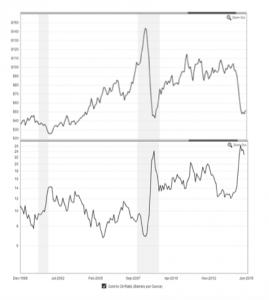Oil prices:
What are the contributing factors and where do we go from here?
 If you would have told investors a year ago that oil prices would fall below $50 a barrel in 2015 they would have laughed at that seemingly impossible prediction. After all, in July of 2014 oil was still trading above $100, with OPEC controlling production and demand still as high as ever. However, once prices started to dip at the tail end of last year they haven’t looked back, failing to trade above $60 since the start of 2015. There are many factors that influence the price of oil in today’s marketplace and where the price of oil will possibly go in the future.
If you would have told investors a year ago that oil prices would fall below $50 a barrel in 2015 they would have laughed at that seemingly impossible prediction. After all, in July of 2014 oil was still trading above $100, with OPEC controlling production and demand still as high as ever. However, once prices started to dip at the tail end of last year they haven’t looked back, failing to trade above $60 since the start of 2015. There are many factors that influence the price of oil in today’s marketplace and where the price of oil will possibly go in the future.
OPEC rules all
In trying to understand the change in oil prices it is first important to examine the actions taken by OPEC. Since its inception, OPEC has controlled production in an effort to control global oil supply, and in turn, affect prices. In the past year OPEC has had a clear goal of attempting to cut the growth of non-OPEC oil supplies, as the recent boom in the US shale market has members of OPEC worried about losing market share. As OPEC has been successful in driving down prices, they have in-turn got their desired result of halting increase production in non-OPEC producing countries.
The boom in US oil shale production has also had its effect on the oil market, however oil from shale is more expensive to produce than crude, so maintaining high levels of output is difficult when prices are down. One OPEC official felt confident about the impending increased demand for OPEC production, stating, “There are strong indications that U.S. shale producers are taking a hit, and by the second half of this year a lot of marginal barrels will disappear from the market and demand will rise for OPEC members.” If this is true the question becomes whether OPEC will continue its strategy of holding prices down in order to completely crush the shale market.
The most recent news out of OPEC is a sharp increase in production, with OPEC supply jumping to 31 million barrels per day in March, the largest supply increase since June 2011. The biggest OPEC country to watch will be Iran, where the 7th highest oil producing country in the world could drastically impact oil supplies in the coming year. If sanctions on Iran are lifted permanently the question becomes how quickly they will be able to ramp up output and exports, and possibly in turn flood the oil market.
China stockpiles reserves
Meanwhile, in the Far East, China continues its oil-buying frenzy. So far in April, Chinaoil, China’s state-run petroleum corporation has purchased 9.5 million barrels for delivery this summer. This is the largest market purchase since October of last year for the country, and there is still half a month of trading still remaining. Analysts differ on whether China is simply stockpiling oil reserves while prices are still low, or speculating in the market in an attempt to profit. Depending on the true motive behind the purchases, China’s buying power could have a strong effect on the oil market through the end of the month and possibly beyond.
Follow the money?
It seems in the US at least, investors aren’t betting on an oil turnaround anytime soon. Money has started to pour out of oil in the US, as there has been a capital outflow of $338 million from four of the largest oil ETFs in just over two weeks of April alone. This has been the first outflow of capital from the funds since early 2014. One reason for the outflows could be investors are now worried their initial prediction that oil prices would rebound quickly from last year’s plummet is not coming to fruition. It appears investors are now concerned the rebound in oil prices could possibly take years, and they don’t want to be caught in a stagnant market that is struggling to recover.
Watch out for exchange rates
How will exchange rates and the strong US dollar play in to this market? There is empirical evidence to suggest that a strong currency value in turn affects oil demand. A study carried out in 2012 by a Belgian university found that, all else being equal, the appreciation of the US dollar exchange rate leads to a significant decline in oil demand for a sample of 65 oil-importing countries. This decline in demand turns out to be larger than the impact of a shift in the global oil price. The oncoming recent strength of the dollar in the currency market may have been a leading factor in the sharp decline in the price of oil.
The oil markets are priced in dollars; however the majority of the world’s oil is consumed outside of the US. This means, as the dollar fluctuates in price it can greatly swing the price of oil in non-US economies. Although countries outside of the US will not see the effect of this market change in currency price, it will have a great impact on the US market. Fluctuations in the currency market have no bearing on true supply or demand, but can be a major short to medium term factor in oil market pricing.
Predict the price of gold, and oil will follow
It has already been discussed how the currency markets affect the price of oil, but another seemingly large factor of predicting the price of oil is the gold market. The price of gold is highly dependent on currencies and market sentiment, making it a great economic barometer. One interesting chart to look at is the price of oil as it relates to the price of gold, which is essentially the amount of oil that can be purchased per one ounce of gold. When looking at these two charts (price of oil vs. gold to oil ratio), an interesting picture emerges. There is a distinct, almost direct, inverse relationship between the price of oil and the ratio of gold to oil prices. When a large amount of oil can be purchased per one ounce of gold, oil prices are at their lowest. This gives us an idea that when attempting to predict the next move in oil prices it may be useful to think about where we anticipate gold to be trading in the future and take that into account. It also illustrates where a binary option trade could be used to ‘hedge’ an investment in a different asset.
Where do we go from here?
No one wants the uncertain job of predicting the next move in oil prices. The next 12 months provide somewhat of a crossroads, as OPEC’s stronghold on supply and the strong US dollar have weighed significantly on any upward momentum shown in the marketplace. OPEC, while wanting to put a clamp down on prices to suppress the growing US shale industry, has no incentive to keep prices down forever. Additionally, it seems that China may be taking advantage of what it thinks is the bottom of oil prices by stockpiling reserves. While it would be extremely difficult to predict the next move in oil, maybe we have hit the tail-end of the downward spiral that the commodity has seen in the past year.